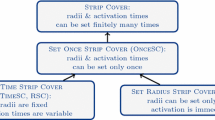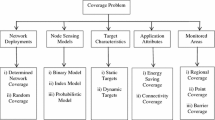Abstract
Given n sensors on an interval, each of which is equipped with an adjustable sensing radius and a unit battery charge that drains in inverse linear proportion to its radius, what schedule will maximize the lifetime of a network that covers the entire interval? Trivially, any reasonable algorithm is at least a 2-approximation for this Sensor Strip Cover problem, so we focus on developing an efficient algorithm that maximizes the expected network lifetime under a random uniform model of sensor distribution. We demonstrate one such algorithm that achieves an expected network lifetime within 12 % of the theoretical maximum. Most of the algorithms that we consider come from a particular family of RoundRobin coverage, in which sensors take turns covering predefined areas until their battery runs out.










Similar content being viewed by others
Notes
We use the terms strip and interval interchangeably to refer to the one-dimensional coverage region.
Please see Remark 1 and the Open Problems section for a discussion of conditions under which the latter assumption can be lifted without loss of generality.
We will occasionally abuse notation by using T to refer to either the lifetime of the system, or the random variable giving the lifetime of a sensor. The precise meaning should be clear from context.
Note that the first and last intervals, U k (0)=[0,2−k−1] and U k (2k)=[1−2−k−1,1], respectively, are only half as wide as the others, all of which have width 2−k.
If the integers from 1 to 2k−1 were placed in a binary tree, η(i) tell us how high up i is in that tree.
We let Γ k (0) be the set of sensors assigned to U k (0) or U k (2k), and have those run RoundRobin on U after all other sensors complete. Their contribution to the network lifetime becomes negligible as k→∞, so we omit it from our calculations.
The inequality is justified by the preceding argument that in practice, the actual load balancing will work at least this well.
References
Alt, H., Arkin, E.M., Brönnimann, H., Erickson, J., Fekete, S.P., Knauer, C., Lenchner, J., Mitchell, J.S.B., Whittlesey, K.: Minimum-cost coverage of point sets by disks. In: Proceedings of the 22nd ACM Symposium on Computational Geometry, pp. 449–458 (2006)
Bar-Noy, A., Baumer, B.: Maximizing network lifetime on the line with adjustable sensing ranges. In: Proceedings from the 7th International Symposium on Algorithms for Sensor Systems, Wireless Ad Hoc Networks and Autonomous Mobile Entities, pp. 28–41 (2011)
Bar-Noy, A., Baumer, B., Rawitz, D.: Changing of the guards: strip cover with duty cycling. In: Proceedings from the 19th International Colloquium on Structural Information and Communication Complexity, pp. 36–47 (2012)
Bar-Noy, A., Baumer, B., Rawitz, D.: Set it and forget it: approximating the set once strip cover problem (2012). Arxiv preprint arXiv:1204.1082v1
Berman, P., Calinescu, G., Shah, C., Zelikovsky, A.: Efficient energy management in sensor networks. In: Ad Hoc and Sensor Networks, Wireless Networks and Mobile Computing, vol. 2, pp. 71–90 (2005)
Bilò, V., Caragiannis, I., Kaklamanis, C., Kanellopoulos, P.: Geometric clustering to minimize the sum of cluster sizes. In: Proceedings from the 13th Annual European Symposium on Algorithms, pp. 460–471 (2005)
Buchsbaum, A.L., Efrat, A., Jain, S., Venkatasubramanian, S., Yi, K.: Restricted strip covering and the sensor cover problem. In: Proceedings of the 18th Annual ACM-SIAM Symposium on Discrete Algorithms, pp. 1056–1063 (2007)
Cardei, M., Du, D.Z.: Improving wireless sensor network lifetime through power aware organization. Wirel. Netw. 11(3), 333–340 (2005)
Cardei, M., Wu, J.: Coverage in wireless sensor networks. In: Handbook of Sensor Networks: Compact Wireless and Wired Sensing Systems, pp. 432–446. CRC Press, Boca Raton (2004), Chap. 19
Cardei, M., Wu, J., Lu, M.: Improving network lifetime using sensors with adjustable sensing ranges. Int. J. Sens. Netw. 1(1/2), 41–49 (2006)
Cardei, M., Wu, J., Lu, M., Pervaiz, M.O.: Maximum network lifetime in wireless sensor networks with adjustable sensing ranges. In: Proceedings from the 3rd IEEE International Conference on Wireless and Mobile Computing, Networking and Communications, pp. 438–445 (2005)
Chambers, E.W., Fekete, S.P., Hoffmann, H.F., Marinakis, D., Mitchell, J.S.B., Srinivasan, V., Stege, U., Whitesides, S.: Connecting a set of circles with minimum sum of radii. In: Proceedings from the 12th International Symposium on Algorithms and Data Structures, pp. 183–194 (2011)
Dhawan, A., Prasad, S.K.: A distributed algorithmic framework for coverage problems in wireless sensor networks. Int. J. Parallel Emerg. Distrib. Syst. 24(4), 331–348 (2009)
Gibson, M., Kanade, G., Krohn, E., Pirwani, I.A., Varadarajan, K.R.: On clustering to minimize the sum of radii. SIAM J. Comput. 41(1), 47–60 (2012)
Gibson, M., Varadarajan, K.R.: Optimally decomposing coverings with translates of a convex polygon. Discrete Comput. Geom. 46(2), 313–333 (2011)
Lev-Tov, N., Peleg, D.: Polynomial time approximation schemes for base station coverage with minimum total radii. Comput. Netw. 47(4), 489–501 (2005)
Mitzenmacher, M., Upfal, E.: Probability and Computing—Randomized Algorithms and Probabilistic Analysis. Cambridge University Press, Cambridge (2005)
Phelan, B., Terlecky, P., Bar-Noy, A., Brown, T., Rawitz, D.: Should I stay or should I go? Maximizing lifetime with relays. In: Proceedings from the 8th IEEE International Conference on Distributed Computing in Sensor Systems, pp. 1–8 (2012)
Saipulla, A., Westphal, C., Liu, B., Wang, J.: Barrier coverage of line-based deployed wireless sensor networks. In: Proceedings from the 28th IEEE International Conference on Computer Communications, pp. 127–135 (2009)
Taniguchi, Y., Kitani, T., Leibnitz, K.: A uniform airdrop deployment method for large-scale wireless sensor networks. Int. J. Sens. Netw. 9(3/4), 182–191 (2011)
Wang, L., Xiao, Y.: A survey of energy-efficient scheduling mechanisms in sensor networks. Mob. Netw. Appl. 11(5), 723–740 (2006)
Weisstein, E.W.: q-series. From MathWorld—A Wolfram Web Resource. http://mathworld.wolfram.com/q-Series.html
Wu, J., Yang, S.: Energy-efficient node scheduling models in sensor networks with adjustable ranges. Int. J. Found. Comput. Sci. 16(1), 3–17 (2005)
Author information
Authors and Affiliations
Corresponding author
Additional information
A preliminary version of this work appeared in [2].
Rights and permissions
About this article
Cite this article
Bar-Noy, A., Baumer, B. Average Case Network Lifetime on an Interval with Adjustable Sensing Ranges. Algorithmica 72, 148–166 (2015). https://doi.org/10.1007/s00453-013-9853-5
Received:
Accepted:
Published:
Issue Date:
DOI: https://doi.org/10.1007/s00453-013-9853-5




